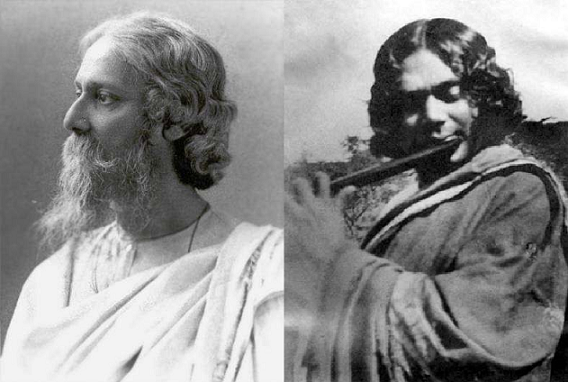Lyricism and Revolution:
Tagore’s Sanchayita vs. Nazrul’s Sanchita
Written By Arun kumar ghosh

In the vast expanse of Bengali literature, two luminaries shine brightly, illuminating the cultural landscape with their brilliance: Rabindranath Tagore and Kazi Nazrul Islam. Their names are etched in the annals of literary history, revered for their profound contributions to poetry and literature. Tagore, the Nobel laureate whose poetic genius transcended borders, and Nazrul, the fiery bard of rebellion whose verses ignited the flames of revolution, stand as pillars of inspiration for generations of readers and poets alike.
Their respective anthologies, Sanchayita by Tagore and Sanchita by Nazrul, stand as timeless reservoirs of poetic wisdom, capturing the multifaceted, far-sighted essence of human existence. In these collections, we encounter a tapestry of emotions, ranging from love and longing to anguish and defiance. Each poem is a jewel, polished with exquisite craftsmanship and imbued with layers of meaning that resonate with readers across generations.
Sanchayita and Sanchita, the distinguished anthologies of Rabindranath Tagore and Kazi Nazrul Islam respectively, hold a revered place in Bengali literature. These collections not only reflect the poets' individual genius but also embody the cultural and ideological currents of their times. Through a deeper analysis of their themes, styles, and impacts, we can appreciate how Tagore's lyrical musings and Nazrul's revolutionary zeal complement and contrast each other, enriching both Bengali and world literature.
Tagore's ethereal lyricism and Nazrul's fervent revolutionary spirit create a dynamic interplay. One of the most iconic poems from Sanchayita is "Where the Mind is Without Fear," a lyrical masterpiece that articulates Tagore's vision of an ideal society:
Where the mind is without fear
And the head is held high;
Where knowledge is free;
Where the world has not been broken up
Into fragments by narrow domestic walls...
In these lines, Tagore yearns for a world liberated from the shackles of ignorance and prejudice, where the pursuit of knowledge is revered, and individuals are free to soar to the heights of their aspirations.
In contrast, Sanchita, the anthology by Kazi Nazrul Islam, pulsates with the fervour of rebellion and the tumult of social upheaval. Nazrul, often hailed as the "rebel poet" of Bengal, was a fierce advocate for social justice and liberation. His verses, like fiery arrows shot into the heart of oppression, galvanized the masses to rise against tyranny and injustice. In Bidrohi (The Rebel), Nazrul channels the collective angst and aspirations of the downtrodden:
I am the Rebel—eternal, unyielding;
Raising my head beyond this world and high!
The sky does not break nor the world collapse
By the flame of revolt that I am, unquenchable!
In these lines, Nazrul embodies the indomitable spirit of resistance, urging individuals to defy the chains of oppression and assert their freedom with unwavering resolve.
As we traverse the poetic landscapes of Sanchayita and Sanchita, we encounter a myriad of themes and emotions that reflect the human experience in all its complexity. From the serene contemplation of nature to the passionate outcry against injustice, Tagore and Nazrul weave a rich tapestry of words that resonates with the hearts and minds of readers across time and space.
In essence, Sanchayita by Rabindranath Tagore and Sanchita by Kazi Nazrul Islam represent towering landmarks in the vast landscape of Bengali literature. They serve not only as literary masterpieces but also as profound reflections of the human condition and society's collective consciousness. These anthologies stand as testaments to the timeless potency of poetry, capable of stirring souls, igniting revolutions, and fostering profound societal change.
Tagore and Nazrul, through their anthologies, extend an invitation to readers to delve into the depths of existence, to contemplate the mysteries of life and the universe. In the serene tranquility of Tagore's poetry, we find solace and introspection, a gentle reminder of the beauty that surrounds us and the interconnectedness of all things. Conversely, in the fiery passion of Nazrul's poetry, we encounter a call to arms, a rallying cry against injustice and oppression, urging us to confront the harsh realities of the world and strive for a more equitable and just society.
Through their words, Tagore and Nazrul inspire us to transcend our limitations, to rise above narrow-mindedness and prejudice, and to embrace a more inclusive and compassionate worldview. They remind us of the transformative power of art and the profound impact that poetry can have on individuals and societies alike. In their poetry, we find not only beauty and wisdom but also a potent catalyst for social change and collective evolution.
Tagore's influence on Bengali literature is immeasurable. He modernized Bengali poetry by incorporating elements of romanticism and realism, breaking away from the more rigid classical forms. His works cover a great array of genres, including poetry, and others, each marked by a precise and profound humanism and a quest for truth. His works were translated into numerous languages, introducing the richness of Bengali literature to the world. Tagore's vision of a universal humanity, as seen in his establishment of Visva Bharati University, sought to bridge Eastern and Western philosophy, ethics and cultures, promoting and uplifting a global dialogue that transcends geographical and cultural boundaries.
On the other, Nazrul’s contribution to Bengali literature is equally significant but operates on a different axis. Known as the Bidrohi Kobi (The Rebel Poet), Nazrul's works provided a voice to the voiceless and challenged the status quo. His poems, songs, and essays were instrumental in inspiring the masses during the Indian independence movement. Nazrul's Sanchita encapsulates his revolutionary zeal and his commitment to social justice, making his poetry a powerful tool for political and social change. On the global stage, Nazrul's works resonate with the same fiery passion and call to action, cementing his place as a significant figure in the literary canon.






0 Comments